Bertrand II (died 1187) was the Archbishop of Trani from 1157 until his death. [1] In 1167 he was sent to Constantinople to arrange a marriage alliance for William II with the Byzantine Empire. [2] He also exposed a conspiracy by Maio of Bari to kill Robert of San Giovanni. His successor was Samarus.
Year 1111 (MCXI) was a common year starting on Sunday of the Julian calendar.
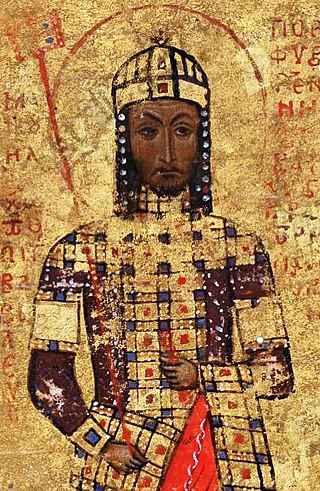
Manuel I Komnenos, Latinized Comnenus, also called Porphyrogennetos, was a Byzantine emperor of the 12th century who reigned over a crucial turning point in the history of Byzantium and the Mediterranean. His reign saw the last flowering of the Komnenian restoration, during which the Byzantine Empire had seen a resurgence of its military and economic power and had enjoyed a cultural revival.
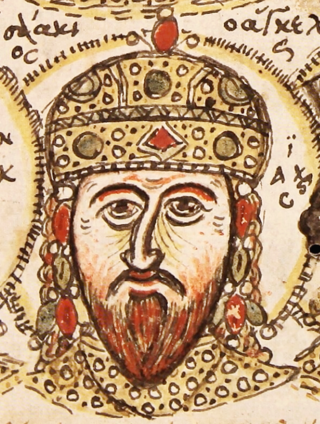
Isaac II Angelos or Angelus was Byzantine Emperor from 1185 to 1195, and again from 1203 to 1204.

RobertGuiscard, sometimes Robert "the Guiscard", also nicknamed “Terror Mundi” was a Norman adventurer remembered for the conquest of southern Italy and Sicily.
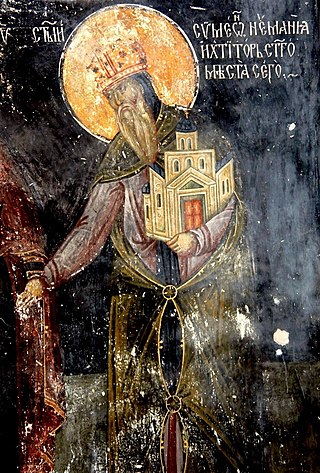
Stefan Nemanja was the Grand Prince of the Serbian Grand Principality from 1166 to 1196. A member of the Vukanović dynasty, Nemanja founded the Nemanjić dynasty, and is remembered for his contributions to Serbian culture and history, founding what would evolve into the Serbian Empire, as well as the national church. According to the Serbian Academy of Sciences and Arts, Nemanja is also among the most remarkable Serbs for his literary contributions and altruistic attributes.
Pope John VIII was the bishop of Rome and ruler of the Papal States from 14 December 872 to his death. He is often considered one of the ablest popes of the 9th century.

The Catepanateof Italy was a province of the Byzantine Empire from 965 until 1071. At its greatest extent, it comprised mainland Italy south of a line drawn from Monte Gargano to the Gulf of Salerno. North of that line, Amalfi and Naples also maintained allegiance to Constantinople through the catepan. The Italian region of Capitanata derives its name from katepanikion.
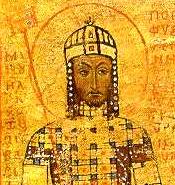
The Battle of Sirmium, Battle of Semlin or Battle of Zemun was fought on July 8, 1167 between the Byzantine Empire, and the Kingdom of Hungary. The Byzantines achieved a decisive victory, forcing the Hungarians to sue for peace on Byzantine terms. The battle consolidated Byzantine control of the western Balkans.

The Duchy of Naples began as a Byzantine province that was constituted in the seventh century, in the reduced coastal lands that the Lombards had not conquered during their invasion of Italy in the sixth century. It was governed by a military commander (dux), and rapidly became a de facto independent state, lasting more than five centuries during the Early and High Middle Ages. Naples remains a significant metropolitan city in present-day Italy.

The Komnenian restoration is the term used by historians to describe the military, financial, and territorial recovery of the Byzantine Empire under the Komnenian dynasty, from the accession of Alexios I Komnenos in 1081 to the death of Andronikos I Komnenos in 1185. At the onset of the reign of Alexios I, the empire was reeling from its defeat by the Seljuk Turks at the Battle of Manzikert in 1071. The empire was also being threatened by the Normans of Robert Guiscard, who were invading the Balkans from their base in southern Italy. All this occurred as the empire's military institution was in disarray and had grown increasingly reliant on mercenaries. Previous emperors had also squandered the large gold deposits of Constantinople, so the defense of the empire had broken down, and there were few troops to fill the gaps.

The Principality of Capua was a Lombard state centred on Capua in Southern Italy, usually de facto independent, but under the varying suzerainty of Holy Roman and Eastern Roman Empires. It was originally a gastaldate, then a county, within the principality of Salerno.
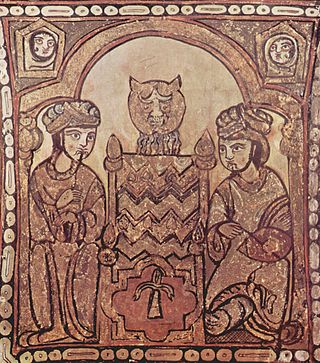
The history of Islam in Sicily and Southern Italy began with the first Arab settlement in Sicily, at Mazara, which was captured in 827. The subsequent rule of Sicily and Malta started in the 10th century. The Emirate of Sicily lasted from 831 until 1061, and controlled the whole island by 902. Though Sicily was the primary Muslim stronghold in Italy, some temporary footholds, the most substantial of which was the port city of Bari, were established on the mainland peninsula, especially in mainland Southern Italy, though Muslim raids, mainly those of Muhammad I ibn al-Aghlab, reached as far north as Naples, Rome and the northern region of Piedmont. The Arab raids were part of a larger struggle for power in Italy and Europe, with Christian Byzantine, Frankish, Norman and local Italian forces also competing for control. Arabs were sometimes sought as allies by various Christian factions against other factions.
Desa was the Serbian co-ruler from 1148 to 1153, alongside his elder brother Uroš II, Grand Prince of Serbia; the Prince of Duklja, Travunija and Zahumlje from 1149 to 1162; the Grand Prince of Serbia from 1153 to 1155, and again from 1162 to 1166.

The Norman conquest of southern Italy lasted from 999 to 1139, involving many battles and independent conquerors.

Wars between the Normans and the Byzantine Empire were fought from c. 1040 until 1185, when the last Norman invasion of the Byzantine Empire was defeated. At the end of the conflict, neither the Normans nor the Byzantines could boast much power, as by the mid-13th century exhaustive fighting with other powers had weakened both, leading to the Byzantines losing Asia Minor to the Ottoman Empire in the 15th century, and the Normans losing Sicily to the Hohenstaufen.

Vitale II Michiel was Doge of Venice from 1156 to 1172.

The term Norman–Arab–Byzantine culture, Norman–Sicilian culture or, less inclusively, Norman–Arab culture, refers to the interaction of the Norman, Byzantine Greek, Latin, and Arab cultures following the Norman conquest of the former Emirate of Sicily and North Africa from 1061 to around 1250. The civilization resulted from numerous exchanges in the cultural and scientific fields, based on the tolerance shown by the Normans towards the Latin- and Greek-speaking Christian populations and the former Arab Muslim settlers. As a result, Sicily under the Normans became a crossroad for the interaction between the Norman and Latin Catholic, Byzantine–Orthodox, and Arab–Islamic cultures.

Grand Principality of Serbia, or Rascia, was a medieval Serbian state that existed from the second half of the 11th century up until 1217, when it was transformed into the Kingdom of Serbia. Initially, the Grand Principality of Serbia emerged in the historical region of Raška, and gradually expanded, during the 12th century, encompassing various neighboring regions, including territories of modern Montenegro, Herzegovina, and southern Dalmatia. It was founded by Grand Prince Vukan, who initially served as regional governor of Raška, appointed by King Constantine Bodin. During Byzantine-Serbian wars Vukan gained prominence and became self-governing ruler in inner Serbian regions. He founded the Vukanović dynasty, that ruled the Grand Principality. Through diplomatic ties with the Kingdom of Hungary, Vukan′s successors managed to retain their self-governance, while also recognizing the supreme overlordship of the Byzantine Empire, up to 1180. Grand Prince Stefan Nemanja (1166–1196) gained full independence and united almost all Serbian lands. His son, Grand Prince Stefan was crowned King of Serbia in 1217, while his younger son Saint Sava became the first Archbishop of Serbs, in 1219.
The siege of Braničevo was laid by Hungarian king Géza II against Byzantine-held Braničevo in late 1154.